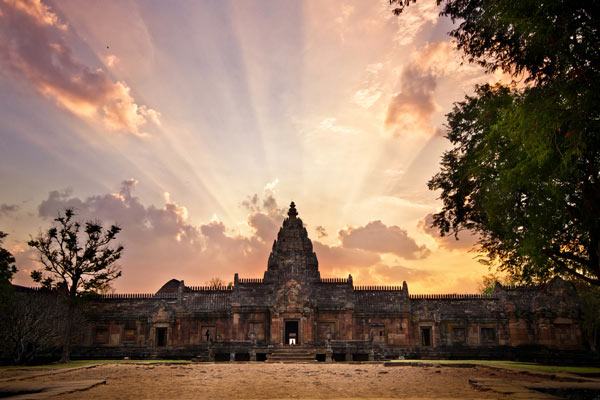Thailand’s “Rose of the North” is a cultural and natural wonderland with ethnic diversity, a multitude of attractions and welcoming hospitality.
 Chiang Mai literally means “new city” and has retained the name despite celebrating its 700th anniversary in 1996. King Meng Rai the Great founded the city as the capital of the Lanna Kingdom on Thursday, April 12 1296 around the same time as the establishment of the Sukhothai Kingdom. King Meng Rai even conferred with his friends, King Ramkhamhaeng of Sukhothai and King Ngam Muang of Phayao before choosing the site where the capital of the Lanna Kingdom was to be founded. Henceforth, Chiang Mai not only became the capital and cultural core of the Lanna Kingdom, it was also to be the center of Buddhism in northern Thailand. King Meng Rai himself was a very religious leader who even founded many of the city’s temples that remain important to this day. Chiang Mai is one of the few places in Thailand where it is possible to experience both historical and modern Thai culture coexisting side by side: the city features centuries-old pagodas and temples next to modern convenience stores and boutique hotels. This dichotomy is best appreciated within the moat-encircled old city, which retains much of the fortified wall that once protected the city center as well as the four main gates that provided access to the former Lanna capital city. Strangely, for many years tourists had mistaken Chiang Mai simply as the base from which they could plan trekking and rafting trips to hill tribe villages and explore other provinces. Once in Chiang Mai, however, tourists are surprised by the fact that there are so many things to discover other than its beautiful and historic temples. Intriguing diversity among ethnic tribes, a number of elephant camps, many cooking and massage schools, numerous outdoor activities, a variety of handicrafts workshops, various cultural performances, and breathtaking scenery make Chiang Mai one of Asia’s most attractive tourist destinations. The phrase "a day in Chiang Mai is enough to see things around town" was once a common expression. Today, two weeks in Chiang Mai may not be long enough for travelers to experience all that Chiang Mai has to offer.
Chiang Mai literally means “new city” and has retained the name despite celebrating its 700th anniversary in 1996. King Meng Rai the Great founded the city as the capital of the Lanna Kingdom on Thursday, April 12 1296 around the same time as the establishment of the Sukhothai Kingdom. King Meng Rai even conferred with his friends, King Ramkhamhaeng of Sukhothai and King Ngam Muang of Phayao before choosing the site where the capital of the Lanna Kingdom was to be founded. Henceforth, Chiang Mai not only became the capital and cultural core of the Lanna Kingdom, it was also to be the center of Buddhism in northern Thailand. King Meng Rai himself was a very religious leader who even founded many of the city’s temples that remain important to this day. Chiang Mai is one of the few places in Thailand where it is possible to experience both historical and modern Thai culture coexisting side by side: the city features centuries-old pagodas and temples next to modern convenience stores and boutique hotels. This dichotomy is best appreciated within the moat-encircled old city, which retains much of the fortified wall that once protected the city center as well as the four main gates that provided access to the former Lanna capital city. Strangely, for many years tourists had mistaken Chiang Mai simply as the base from which they could plan trekking and rafting trips to hill tribe villages and explore other provinces. Once in Chiang Mai, however, tourists are surprised by the fact that there are so many things to discover other than its beautiful and historic temples. Intriguing diversity among ethnic tribes, a number of elephant camps, many cooking and massage schools, numerous outdoor activities, a variety of handicrafts workshops, various cultural performances, and breathtaking scenery make Chiang Mai one of Asia’s most attractive tourist destinations. The phrase "a day in Chiang Mai is enough to see things around town" was once a common expression. Today, two weeks in Chiang Mai may not be long enough for travelers to experience all that Chiang Mai has to offer.

Private buses, which can be conveniently booked in tourist centers in Bangkok, are also available. However, the public busses from the Northern Bus Terminal are generally more reliable. The journey takes approximately 10-12 hours, depending on traffic.
From other provinces, including Mae Sai, Chiang Saen, Chiang Rai, Nan, Phayao, Phrae, Lampang, Lamphun, Phitsanulok, Sukhothai, Mae Hong Son, Mae Sot, Mae Sariang, Khon Kaen, Nakhon Ratchasima (Khorat), and Udon Thani, there are direct busses that service the Chiang Mai Arcade Bus Station. Contact tel: 0 5324 2664 for an updated bus timetable.
From international destinations, visitors can fly directly to Chiang Mai on a number of domestic and international air carriers. While these routes are subject to their economic viability for individual airlines, it is usually possible to fly directly to Chiang Mai from Kuala Lumpur, Luang Prabang, Singapore, Vientiane, and Yangon. International airlines servicing Chiang Mai from those destinations include Silk Air, Lao Airlines, and Mandalay Air.






